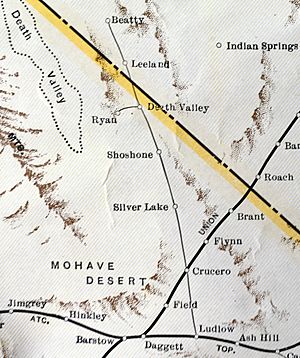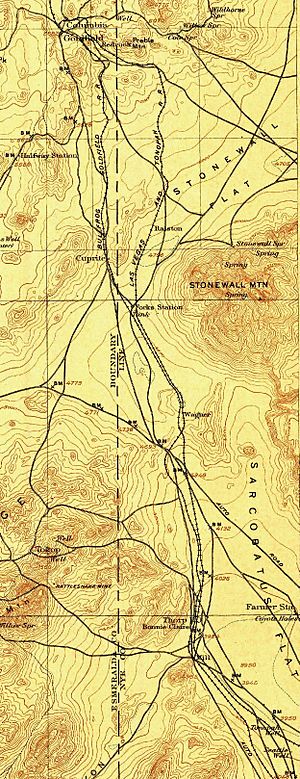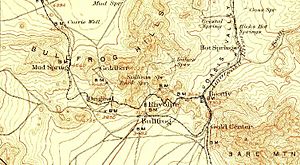Tonopah and Tidewater Railroad facts for kids
 |
|
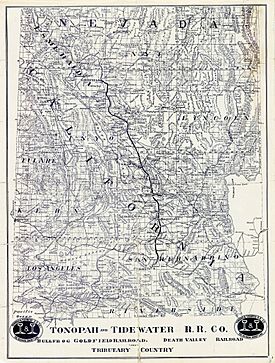
Map showing the route of the T&T.
|
|
| Overview | |
|---|---|
| Headquarters | Ludlow, California |
| Reporting mark | T&T |
| Locale | Ludlow, California, to Gold Center, Nevada (later extended to Beatty, Nevada, and Goldfield, Nevada, by way of the Bullfrog Goldfield Railroad in 1908) |
| Dates of operation | 1904–1940 |
| Technical | |
| Track gauge | 4 ft 8 1⁄2 in (1,435 mm) standard gauge |
The Tonopah and Tidewater Railroad (reporting mark T&T) was a railway that operated in eastern California and southwestern Nevada. It was known as a "Class II railroad," meaning it was a medium-sized railway company.
This railroad was mainly built to carry borax, a mineral used in many products, from Francis Marion Smith's mines. These mines, owned by the Pacific Coast Borax Company, were located just east of Death Valley. The T&T also transported lead, clay, and other goods. It carried passengers too! The railway connected to the Atchison, Topeka and Santa Fe Railway at Ludlow, California. It also linked up with the Los Angeles and Salt Lake Railroad (which later became the Union Pacific Railroad) at Crucero, California.
The railroad was supposed to go from Tonopah, Nevada, all the way to San Diego, California. San Diego is on the coast, which is why the name includes "Tidewater." However, the T&T never reached either city on its own tracks. It was famous for being the last of three railroads built to cross the Death Valley area. It also lasted longer than the others, providing important service to people living in the desert for over 30 years. The T&T was even part of a bigger plan for a north-south railway route across the country.
The Tonopah and Tidewater Railroad ran from 1907 until 1940. It stopped operating because it wasn't making enough money. Its tracks were removed in 1943 to be used for materials during World War II. The company officially closed down by 1946.
Contents
Building the Desert Railway

Francis Marion Smith was a very successful businessman in California. He was known for his mining companies. In 1890, he started the Pacific Coast Borax Company. His mine at Borate was the largest borax mine in the world. He even had a small railway, the Borate and Daggett Railroad, to move the borax. Smith also built many train systems around Oakland, California and San Francisco, California.
Around 1901, Smith found new borax deposits in the Black Mountains (California). These were east of Death Valley. The new mine, called Lila C., was about 135 miles (217 km) from the nearest railway. To get the borax out, he first tried using a steam tractor. But the desert was too harsh for it.
Smith then decided to build a new railroad. He wanted to connect the Lila C. mine to his processing plants in California and New Jersey. He also hoped to extend the railway to Tonopah, Nevada. This area was booming with gold and silver mines. On July 19, 1904, Francis Marion Smith officially started the Tonopah & Tidewater Railroad Company.
Smith first thought about building the railway from different places. He met William A. Clark, a senator from Montana, in Las Vegas, Nevada. Clark suggested building the T&T from Las Vegas. This seemed like the fastest way to the borax mine and the goldfields. Smith liked the idea. However, Clark was also planning his own railway to Tonopah. This made things complicated for him.
Starting Construction
In 1905, Francis Marion Smith sent teams to Las Vegas to start building the Tonopah & Tidewater Railroad. They began preparing the ground on May 29. By mid-July, about 12 miles (19 km) of the railway path was ready.
William Clark tried to stop Smith from building his railroad. He raised prices for building materials. He even built a road from Las Vegas to Beatty to compete. The biggest problem was when Clark's railway officials refused to let the T&T connect to their main line. Smith tried to talk to Clark, but Clark was in Paris, avoiding him. There, Clark decided to build his own railway, which became the Las Vegas and Tonopah Railroad.
Despite this setback, Smith didn't hold a grudge. Instead, he went to the Atchison, Topeka and Santa Fe Railway. He suggested using their stop at Ludlow, California, as the T&T's new starting point. This was a smart move, as Clark and the Santa Fe were rivals. Building north from Ludlow also meant more business for the T&T from other mines. The main downside was that the railway would be twice as long, about 200 miles (320 km).
Francis Smith sold all his Las Vegas railway work and supplies to Clark. He then moved to Ludlow and started building the T&T with new materials from the Santa Fe. Construction began in November. The summer heat made work very difficult. Getting water was a huge challenge.
The T&T construction teams reached Crucero, California, by 1906. Here, they had to cross the main line of the San Pedro, Los Angeles and Salt Lake Railroad. They made an agreement to use Crucero as a shared point. After some talks, they agreed, and the T&T crews continued north.
The hardest part of building the Tonopah and Tidewater Railroad was getting through the Amargosa Canyon. It took thousands of mules and men to blast a path through the canyon. This work took almost three years to reach Tecopa, California. The Tonopah and Tidewater reached Death Valley Junction, California, by 1907. This was the closest point to the Lila C. borax mine. A branch line was built to the mine, and trains immediately began carrying borax to the Santa Fe.
The last spike was put in place at Gold Center, Nevada. There was no big celebration. The Las Vegas and Tonopah Railroad had already reached Goldfield. Also, a financial crisis in 1907 was hurting the gold mines.
Still, the Tonopah and Tidewater was in a better position to make money than the Las Vegas and Tonopah. In 1908, the T&T joined with the Bullfrog Goldfield Railroad to reach Goldfield. This also connected them to Tonopah through the Tonopah and Goldfield Railroad. The T&T offered lower prices and a shorter route. Passengers preferred the T&T because it was 100 miles (160 km) shorter to get to Los Angeles. By the time World War I started, the Las Vegas and Tonopah Railroad was struggling. The government took over both the T&T and LV&T during the war. They decided the LV&T was not needed, and its tracks were removed in 1918.
The Lila C. mines ran out of borax by 1913. The T&T wanted to extend their branch line to new mines at Ryan, California. But because they owed over $4.4 million, they were not allowed to. Instead, the Pacific Coast Borax Company built a new, smaller railway, the 3 ft-gauge Death Valley Railroad. This railway carried ore from Ryan to the T&T at Death Valley Junction.
The End of the Line
By 1927, the Pacific Coast Borax Company moved its mining operations to Boron, California. This was 80 miles (130 km) away from Death Valley. The Tonopah and Tidewater had to find other things to transport. They carried lead from Tecopa, and feldspar and clay from Bradford Siding. They also moved gypsum, talc, and general goods. Without the borax mine, the T&T only made a profit for about four years. Then, its money dropped sharply. The Bullfrog Goldfield Railroad closed in 1928. This cut off the T&T's link to Goldfield and Tonopah. The T&T had to shorten its tracks to Beatty.
The T&T tried to attract tourists to Death Valley to stay in business. They worked with the Union Pacific to offer special train services from Los Angeles. Tourists could transfer to the T&T at Crucero and travel to Death Valley Junction. From there, they could explore the valley and stay at hotels like the Furnace Creek Inn. However, the Great Depression severely hurt tourism. People also started using cars to get to the valley.
It became clear that the T&T was losing too much money. Maintenance costs were very high because of floods that damaged the tracks. By 1938, the railroad, sometimes called the "Tired and Tardy," owed over $5 million.
The T&T applied to close down its operations in 1938. Many local businesses protested because they depended on the railway. But the government eventually approved the closure in 1940. The railroad was put on hold, hoping to reopen if traffic improved. However, when the United States entered World War II in 1941, all of the T&T's rails and equipment were taken by the War Department for use in Europe. It took almost a year to remove the entire railway between Ludlow and Beatty. Only the old trackbed and a few ties were left in the desert.
Much of the wood from the ties and bridges was used to build new structures. These included the Apple Valley Inn in Apple Valley, California, and the El Rancho Motel in Barstow, California. Some buildings in Tecopa, California, and the hot springs facilities, were also built from old T&T railroad ties. Harry Rosenberg Sr., a foreman for the railroad, built many of them.
Today, only a few pieces of the T&T still exist. These include a boxcar, a flatcar, a caboose, a passenger car, a diner car, a handcar, and a gas-driven railcar #99. Other remaining items are in museums and private collections in the Mojave Desert.
Museum and Preservation
A group called the Tonopah & Tidewater Railroad Historical Society was started in 2015. Their goal is to save the history of this old desert railway. They also plan to build a model railway of the T&T, showing its route from Ludlow, California, to Death Valley Junction. The museum was first located at the Amargosa Opera House and Hotel in Death Valley Junction, California. It has since moved to Goldfield, Nevada. The model railroad is not yet running, and the society is looking for a good place to display it.
Locomotives of the T&T
The Tonopah and Tidewater Railroad had a total of 16 locomotives. This included 10 steam locomotives and one gas-driven railcar. Six more steam engines were added when the T&T merged with the Bullfrog Goldfield Railroad in 1908.
| Number | Builder | Type | Works Number | Built | Acquired | Image | Notes |
|---|---|---|---|---|---|---|---|
| #1 | Baldwin Locomotive Works |
|
#14418 | 1895 | 1904 |
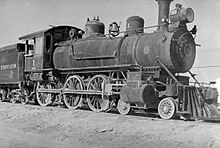 |
This engine was first built for another railroad. It was later used by the Atchison, Topeka and Santa Fe Railway before coming to the T&T in 1905. It was scrapped in 1941, but its bell is saved at the RailGiants Train Museum. |
| #2 | Dickson Manufacturing Company |
|
#454 | 1883 | 1906 |
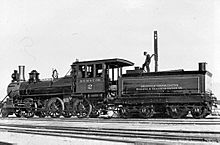 |
Originally built for the Delaware, Lackawanna and Western Railroad. It was sold to the T&T in 1906. In 1910, it went to the Goldfield Consolidated Mining Co. |
| #3 | Unknown | There is some mystery about this engine. It might have been a Baldwin-built 2-8-0 locomotive. Its final fate is unknown. | |||||
| #4 | Baldwin Locomotive Works |
|
#29312 | 1906 | 1906 |
 |
Ordered directly for the Tonopah and Tidewater in 1906. It was later sold to the Santa Maria Valley Railroad in 1913 and scrapped in 1937. |
| #5 | Baldwin Locomotive Works |
|
#31418 | 1907 | 1907 | Ordered directly for the T&T in 1907. It was a sister engine to #6. Sold to the Santa Maria Valley Railroad in 1913 and scrapped in 1937. | |
| #6 | Baldwin Locomotive Works |
|
#31419 | 1907 | 1907 |
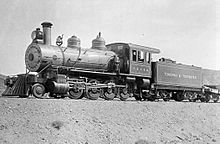 |
Ordered directly for the T&T in 1907. Sister engine to #5. Sold to Pacific Portland Cement Co. |
| #6 (2nd) | Baldwin Locomotive Works |
|
#30107 | 1907 | 1921 | This was originally Las Vegas and Tonopah Railroad #6. It was sold to the T&T in 1921. Later, it helped build the Hoover Dam. It was scrapped around 1936 or 1937. | |
| #7 | Baldwin Locomotive Works |
|
#31750 | 1907 | 1907 |
 |
Ordered directly for the T&T in 1907. Sister engine to #8. Sold to the Tonopah and Goldfield Railroad in 1944 and scrapped in 1948. |
| #8 | Baldwin Locomotive Works |
|
#31791 | 1907 | 1907 |
 |
Ordered directly for the T&T in 1907. Sister engine to #7. It was bought by Henry J. Kaiser Co. and later scrapped in 1947. |
| #9 | Baldwin Locomotive Works |
|
#32292 | 1907 | 1907 |
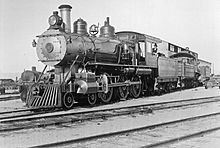 |
Ordered directly for the T&T in 1907. Sister engine to #10. It was sold in 1945 and scrapped in 1946. |
| #10 | Baldwin Locomotive Works |
|
#32293 | 1907 | 1907 | Ordered directly for the T&T in 1907. Sister engine to #9. It was sold in 1945 and scrapped in 1946. | |
| #99 | St. Louis Car Company |
|
#1484/349 | 1928 | 1928 |
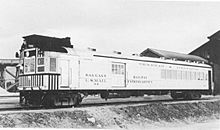 |
This motorcar arrived on Christmas, 1928. It was used for tourist services, pulling passenger cars. It was sold in 1943 to a railway in Mexico and still exists today. |
- Sharp & Fellows #7, an ALCO-Dickson 2-6-2 steam locomotive, helped remove the T&T rails in 1943. It is now preserved at the Travel Town Museum in Los Angeles, California.
Locomotives from Bullfrog Goldfield Railroad
These locomotives became part of the Tonopah and Tidewater Railroad in 1908. This happened when the T&T merged with the Bullfrog Goldfield Railroad.
| Number | Builder | Type | Works Number | Built | Acquired | Image | Notes |
|---|---|---|---|---|---|---|---|
| #3 | Baldwin Locomotive Works |
|
#29712 | 1906 | 1908 |
 |
Originally built for the Bullfrog Goldfield Railroad in 1906. It became T&T property in 1908 but was never used by them. It was later sold to other companies. |
| #4 | Baldwin Locomotive Works |
|
#29713 | 1906 | 1908 | Originally built for the Bullfrog Goldfield Railroad in 1906. It became T&T property in 1908 but was never used by them. It was sold to the Utah Copper Co. | |
| #11 | Baldwin Locomotive Works |
|
#29726 | 1906 | 1908 |
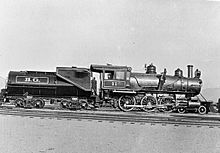 |
Originally Bullfrog Goldfield Railroad #13. It became T&T property in 1908. It was sold in 1917 and scrapped in 1954. |
| #12 | Baldwin Locomotive Works |
|
#29727 | 1906 | 1908 |
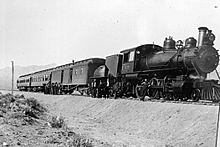 |
Originally Bullfrog Goldfield Railroad #14. It became T&T property in 1908. It was destroyed in a boiler explosion in 1910. Its bell was saved for the schoolhouse at Ludlow, California. |
| #54 | Baldwin Locomotive Works |
|
#29265 | 1906 | 1908 |
 |
Originally built for the Bullfrog Goldfield Railroad in 1906. It became T&T property in 1908. It was sold to the National Railways of Mexico around 1923. |
| #55 | Baldwin Locomotive Works |
|
##29266 | 1906 | 1908 | Originally built for the Bullfrog Goldfield Railroad in 1906. It became T&T property in 1908. It was reportedly sold to the Tonopah and Goldfield Railroad in 1917. |
Rolling Stock
Most of the T&T's freight cars were older, second-hand boxcars from the 1880s and 1890s. Many came from the Delaware, Lackawanna and Western Railroad. Freight was often carried in cars borrowed from other railways for faster shipping.
The T&T also had some new passenger cars. These were Pullman cars with two axles. They also had a few older wooden passenger cars with balconies from the 1890s. Some of these were later changed into work cars. The T&T often attached a passenger car to its trains to carry people. The railway also had a few cabooses, which were used with some trains.
The T&T Route
Many of the stops along the railroad were named after people who worked with Francis Marion Smith. Part of the Tonopah and Tidewater Railroad's route goes through Death Valley National Park. Some sections have been turned into hiking trails for visitors. Other parts of the route are easy for off-road vehicles to access. Much of the old railway path runs next to California State Route 127 between Baker, California and Death Valley Junction, California.
- Ludlow, California (Milepost 0.0): This was where the T&T connected with the Atchison, Topeka and Santa Fe Railway. It was also the location of the T&T's main office and train repair shops.
- Broadwell (MP 12.68)
- Mesquite (MP 21.49)
- Crucero, California (MP 25.68): This was a connection point with the Los Angeles and Salt Lake Railroad (later Union Pacific Railroad).
- Rasor (MP 29.38): Named for Clarence Rasor, a worker for Smith.
- Soda Lake (MP 33.34): Later renamed Zzyzx, California.
- Baker, California (MP 41.82): Formerly Berry, renamed for Richard C. Baker, a business partner of Smith.
- Silver Lake (MP 49.50)
- Talc (MP 56)
- Riggs (MP 59.47): Formerly named Alta.
- Lore (MP 60)
- Valjean (MP 65.11)
- Dumont (MP 74.40): Named after Harry Dumont, who ran the company's San Francisco office.
- Sperry (MP 78.84): Named after Smith's niece, Charlotte Grace Sperry.
- Acme (MP 82.97): Formerly named Morrison.
- Tecopa, California (MP 87.67): A connection point with the Tecopa Railroad.
- Zabriskie (MP 91.74): Named for Christian Brevoort Zabriskie, a superintendent and later in charge of New York operations.
- Shoshone, California (MP 96.95)
- Fitrol Spur (MP 97-98)
- Gerstley, California (MP 101.26): Named for James Gerstley, a business partner of Smith.
- Jay (MP 106.00)
- Death Valley Junction, California (MP 122.01): This was the junction for the Lila C. Branch and connected with the Death Valley Railroad.
- Bradford Siding (MP 128.01): A side track went to clay pits from here.
- Muck (MP 131)
- Jenifer (MP 139.44): Named for Frank Morgan Jenifer, the president of the railroad.
- Leeland, Nevada (MP 144.51)
- Ashton (MP 154.98)
- Carrara, Nevada (MP 160.55): Connected to a cable tramway that went to a stone quarry.
- Post (MP 166): Later renamed Weslead.
- Gold Center, Nevada (MP 166.0): Here, the T&T connected with the Bullfrog Goldfield Railroad heading north to Beatty.
- Beatty Junction (MP 169.07): A connection point with the Las Vegas and Tonopah Railroad.
- Beatty, Nevada (MP 169.07): This was the end of the T&T's main line. Its facilities were shared with other railroads.
The following stops were part of the Bullfrog Goldfield Railroad route. The T&T used them between Beatty and Bonnie Claire, Nevada, from 1908 until 1927.
- Bullfrog, Nevada (MP 170.18)
- Rhyolite, Nevada (MP 171.58): The T&T reached here through a branch line from Beatty, Nevada.
- Wiggers (MP 172.49)
- Rider or Ryders (MP 173)
- Hot Springs (MP 174.49)
- Silica (MP 178)
- Springdale, Nevada (MP 179.39)
- Tolicha (MP 186)
- Ancram (MP 188.59)
- Jacksonville (MP 193.19)
- Merger Mine (MP 194)
- Bonnie Claire, Nevada (MP 206.59): Here, the line joined the Las Vegas and Tonopah Railroad route after 1914. All points below were former LV&T stops used by the T&T and BG after 1914.
- Wagner (MP 218.59)
- Stonewall (MP 227.17)
- Cuprite (MP 227.99)
- Silica (MP 229)
- Ralston (MP 231.47)
- Stella (MP 233.69)
- Keith (MP 240.19)
- Milltown (MP 241.19)
- Bullfrog Junction (MP 241.59): A connection point for the Bullfrog Goldfield Railroad and the Tonopah and Goldfield Railroad.
- Goldfield, Nevada (MP 242.69): This was originally a station for the Tonopah and Goldfield Railroad. The T&T had an office here until 1914.
In Popular Culture
- A song about the Tonopah and Tidewater Railroad was written by Ken Graydon. It has been sung by artists Walt Richards and Paula Strong. You can find it on YouTube.
- The Tonopah & Tidewater Railroad has appeared in some films. These include the 1909 documentary "Trip to Death Valley" and Wallace Beery's 1940 movie 20 Mule Team. It also had a small appearance in an episode of The Rifleman called "Grasshopper." An episode of Death Valley Days, "The Rose of Rhyolite", was based on a real event that happened on the railroad. However, the T&T itself was not used in the episode, as its tracks were gone by then.
- For those who enjoy building model trains, Central Valley Model Works and MDC-Roundhouse offered kits to create model boxcars like those on the T&T. Roundhouse also made Pullman Palace cars that could be labeled "Tonopah & Tidewater." The Narrow Gauge & Shortline Gazette has published diagrams of T&T locomotives for model builders.


